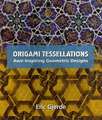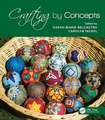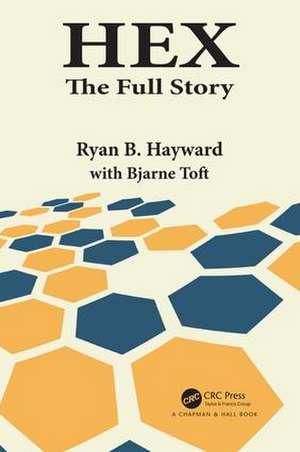Hex: The Full Story: AK Peters/CRC Recreational Mathematics Series
Autor Ryan B. Hayward, Bjarne Toften Limba Engleză Paperback – 29 ian 2019
Features
- New documents on Hein's creation of Hex, the complete set of Danish puzzles, and the identity of their composer
- Chapters on Gale's game Bridg-it, the game Rex, computer Hex, open Hex problems, and more
- Dozens of new puzzles and solutions
- Study guide for Hex players
- Supplemenetary text for a course in game theory, discrete math, computer science, or science history
| Toate formatele și edițiile | Preț | Express |
|---|---|---|
| Paperback (1) | 245.90 lei 3-5 săpt. | +17.44 lei 4-10 zile |
| CRC Press – 29 ian 2019 | 245.90 lei 3-5 săpt. | +17.44 lei 4-10 zile |
| Hardback (1) | 1222.82 lei 6-8 săpt. | |
| CRC Press – 4 feb 2019 | 1222.82 lei 6-8 săpt. |
Din seria AK Peters/CRC Recreational Mathematics Series
-
 Preț: 390.89 lei
Preț: 390.89 lei -
 Preț: 393.72 lei
Preț: 393.72 lei - 8%
 Preț: 393.15 lei
Preț: 393.15 lei -
 Preț: 292.12 lei
Preț: 292.12 lei -
 Preț: 211.03 lei
Preț: 211.03 lei -
 Preț: 191.51 lei
Preț: 191.51 lei -
 Preț: 243.16 lei
Preț: 243.16 lei -
 Preț: 360.48 lei
Preț: 360.48 lei -
 Preț: 201.47 lei
Preț: 201.47 lei - 8%
 Preț: 500.84 lei
Preț: 500.84 lei -
 Preț: 184.01 lei
Preț: 184.01 lei -
 Preț: 293.52 lei
Preț: 293.52 lei -
 Preț: 161.39 lei
Preț: 161.39 lei -
 Preț: 359.04 lei
Preț: 359.04 lei -
 Preț: 176.05 lei
Preț: 176.05 lei -
 Preț: 242.37 lei
Preț: 242.37 lei -
 Preț: 223.47 lei
Preț: 223.47 lei -
 Preț: 317.82 lei
Preț: 317.82 lei -
 Preț: 192.53 lei
Preț: 192.53 lei - 8%
 Preț: 474.63 lei
Preț: 474.63 lei -
 Preț: 360.58 lei
Preț: 360.58 lei -
 Preț: 232.45 lei
Preț: 232.45 lei -
 Preț: 192.32 lei
Preț: 192.32 lei -
 Preț: 282.38 lei
Preț: 282.38 lei - 9%
 Preț: 570.74 lei
Preț: 570.74 lei -
 Preț: 220.61 lei
Preț: 220.61 lei -
 Preț: 223.94 lei
Preț: 223.94 lei -
 Preț: 238.17 lei
Preț: 238.17 lei -
 Preț: 191.94 lei
Preț: 191.94 lei - 8%
 Preț: 417.31 lei
Preț: 417.31 lei - 18%
 Preț: 1063.41 lei
Preț: 1063.41 lei - 26%
 Preț: 1042.56 lei
Preț: 1042.56 lei - 17%
 Preț: 253.55 lei
Preț: 253.55 lei - 25%
 Preț: 496.94 lei
Preț: 496.94 lei - 8%
 Preț: 502.87 lei
Preț: 502.87 lei -
 Preț: 378.60 lei
Preț: 378.60 lei - 26%
 Preț: 933.23 lei
Preț: 933.23 lei -
 Preț: 323.21 lei
Preț: 323.21 lei - 18%
 Preț: 1217.60 lei
Preț: 1217.60 lei - 18%
 Preț: 179.93 lei
Preț: 179.93 lei -
 Preț: 324.46 lei
Preț: 324.46 lei
Preț: 245.90 lei
Nou
Puncte Express: 369
Preț estimativ în valută:
47.06€ • 51.10$ • 39.53£
47.06€ • 51.10$ • 39.53£
Carte disponibilă
Livrare economică 01-15 aprilie
Livrare express 15-21 martie pentru 27.43 lei
Preluare comenzi: 021 569.72.76
Specificații
ISBN-13: 9780367144227
ISBN-10: 0367144220
Pagini: 320
Ilustrații: 190 Line drawings, black and white; 71 Halftones, black and white; 264 Illustrations, black and white
Dimensiuni: 156 x 234 x 22 mm
Greutate: 0.45 kg
Ediția:1
Editura: CRC Press
Colecția CRC Press
Seria AK Peters/CRC Recreational Mathematics Series
ISBN-10: 0367144220
Pagini: 320
Ilustrații: 190 Line drawings, black and white; 71 Halftones, black and white; 264 Illustrations, black and white
Dimensiuni: 156 x 234 x 22 mm
Greutate: 0.45 kg
Ediția:1
Editura: CRC Press
Colecția CRC Press
Seria AK Peters/CRC Recreational Mathematics Series
Public țintă
General and Professional Practice & DevelopmentCuprins
1. Birth. 2. Preparing to launch. 3. Polygon in Politiken. 5. The Polygon puzzlist. 6. Rebirth. 7. More games, and machines. 8. Hex goes global. 9 Is Hex easy? 10. Hex theory. 11. Rex theory. 12. The quest for strategies. 13. The rise of the bots. 14. Epilogue, Chronology. Appendices.
Notă biografică
Ryan B. Hayward is Professor of Computer Science at the University of Alberta, Canada.
Bjarne Toft is Professor Emeritus at the Univeristy of Southern Denmark.
Bjarne Toft is Professor Emeritus at the Univeristy of Southern Denmark.
Recenzii
Click hereto see a review of the book, along with some Hex puzzles set by Oliver Roederof FiveThirtyEight.
“The full story of the game of Hex as told in this ambitious book isin fact two rather distinct stories. On the one hand, there is a deeply humanstory of how the game of Hex came about and how it has developed over theyears; this is a fascinating historical tale full of interesting and oftenbrilliant characters. On the other hand, there is also what is essentially amathematical story of the game itself; what mathematical theory is involved,what sort of strategies are needed to play the game well, how Hex is similar toor different from games such as chess and Go, and how well computers do playingagainst expert human Hex players.
[. . . ] The story of the birth and earlysuccess of Hex has been meticulously researched here and is extremely welltold. In particular, the book contains many wonderful old photographs. [. . .] Atthis point humans still seem to have an advantage over computers on 13 × 13boards and larger, but as the authors say, ‘The story of Hex continues’”
—MathSciNet Mathematical Reviews,American Mathematical Society
". . . this isnot a mathematics textbook, and people who are not terribly interested inmathematical proofs and reasoning will still find much of interest here. Inaddition to discussing some of the mathematics behind the game, for example,the book also addresses at great length the history of Hex [. . .]. In additionto tracing the history of Hex, the authors also include lots of actual puzzles,with solutions, and discuss at length aspects of Hex strategy. Games that arerelated to Hex, such as Bridg-It and Rex (also knownas "reverse Hex"), are also discussed. [. . .] Because of itsmathematical content, instructors of courses in subjects like game theory ordiscrete mathematics might want to flip through it as a potential source oflecture material. People interested in the history of mathematics might findsome of the biographical and historical detail here interesting. And of courseanybody who enjoys the game of Hex will find much of here interest as well.It’s a fun book."
—Mark Hunacek, MAA Reviews
“Any well-definedstrategy game raises at least two mathematical questions: which player (firstor second) wins with best play? and how? Complex games with ad hoc rules (e.g.,chess) generally lack symmetry sufficient to fuel mathematical analysis, but manygames of elegant simplicity still prove fiendishly hard to crack. Topologicalprinciples inspired the creation of Hex by Piet Hein in 1942. Actually a familyof games, Hex is played on rhombuses of various sizes paved with hexagonalcells; players alternately take control of cells while aiming to forge a path,however contorted, connecting opposite sides of the rhombus. Famously, whileJohn Nash proved first players win with best play, his non-constructiveargument offers no insight into the ideal strategy. Complete computer analysisnow handles up to 10 x 10 Hex, but Hein's original 11 x 11 version probablyoffers complexity sufficient for decades more of vital play. The present volumecovers history, variant forms, underlying mathematical ideas, information aboutexhaustive small-board strategies, and state-of-the-art computer play onfull-sized (11 x 11 or 13 x 13) boards. More systematic but less up-to-date,Connections Games by Cameron Browne complements the current volume.”
—D. V. Feldman, University of New Hampshire, CHOICE Reviews
“The full story of the game of Hex as told in this ambitious book isin fact two rather distinct stories. On the one hand, there is a deeply humanstory of how the game of Hex came about and how it has developed over theyears; this is a fascinating historical tale full of interesting and oftenbrilliant characters. On the other hand, there is also what is essentially amathematical story of the game itself; what mathematical theory is involved,what sort of strategies are needed to play the game well, how Hex is similar toor different from games such as chess and Go, and how well computers do playingagainst expert human Hex players.
[. . . ] The story of the birth and earlysuccess of Hex has been meticulously researched here and is extremely welltold. In particular, the book contains many wonderful old photographs. [. . .] Atthis point humans still seem to have an advantage over computers on 13 × 13boards and larger, but as the authors say, ‘The story of Hex continues’”
—MathSciNet Mathematical Reviews,American Mathematical Society
". . . this isnot a mathematics textbook, and people who are not terribly interested inmathematical proofs and reasoning will still find much of interest here. Inaddition to discussing some of the mathematics behind the game, for example,the book also addresses at great length the history of Hex [. . .]. In additionto tracing the history of Hex, the authors also include lots of actual puzzles,with solutions, and discuss at length aspects of Hex strategy. Games that arerelated to Hex, such as Bridg-It and Rex (also knownas "reverse Hex"), are also discussed. [. . .] Because of itsmathematical content, instructors of courses in subjects like game theory ordiscrete mathematics might want to flip through it as a potential source oflecture material. People interested in the history of mathematics might findsome of the biographical and historical detail here interesting. And of courseanybody who enjoys the game of Hex will find much of here interest as well.It’s a fun book."
—Mark Hunacek, MAA Reviews
“Any well-definedstrategy game raises at least two mathematical questions: which player (firstor second) wins with best play? and how? Complex games with ad hoc rules (e.g.,chess) generally lack symmetry sufficient to fuel mathematical analysis, but manygames of elegant simplicity still prove fiendishly hard to crack. Topologicalprinciples inspired the creation of Hex by Piet Hein in 1942. Actually a familyof games, Hex is played on rhombuses of various sizes paved with hexagonalcells; players alternately take control of cells while aiming to forge a path,however contorted, connecting opposite sides of the rhombus. Famously, whileJohn Nash proved first players win with best play, his non-constructiveargument offers no insight into the ideal strategy. Complete computer analysisnow handles up to 10 x 10 Hex, but Hein's original 11 x 11 version probablyoffers complexity sufficient for decades more of vital play. The present volumecovers history, variant forms, underlying mathematical ideas, information aboutexhaustive small-board strategies, and state-of-the-art computer play onfull-sized (11 x 11 or 13 x 13) boards. More systematic but less up-to-date,Connections Games by Cameron Browne complements the current volume.”
—D. V. Feldman, University of New Hampshire, CHOICE Reviews
Click here tosee a review of the book, along with some Hex puzzles set by Oliver Roeder of FiveThirtyEight.
". . . this is not a mathematics textbook, and people whoare not terribly interested in mathematical proofs and reasoning will stillfind much of interest here. In addition to discussing some of the mathematicsbehind the game, for example, the book also addresses at great length thehistory of Hex[. . .]. In addition to tracing the history of Hex, the authorsalso include lots of actual puzzles, with solutions, and discuss at lengthaspects of Hex strategy. Games that are related to Hex, such as Bridg-It andRex (also known as "reverse Hex"), are also discussed. [. . .]Because of its mathematical content, instructors of courses in subjects likegame theory or discrete mathematics might want to flip through it as apotential source of lecture material. People interested in the history ofmathematics might find some of the biographical and historical detail hereinteresting. And of course anybody who enjoys the game of Hex will find much ofhere interest as well. It’s a fun book."
—Mark Hunacek, MAAReviews
“Any well-defined strategy game raises atleast two mathematical questions: which player (first or second) wins with bestplay? and how? Complex games with ad hoc rules (e.g., chess) generally lacksymmetry sufficient to fuel mathematical analysis, but many games of elegantsimplicity still prove fiendishly hard to crack. Topological principlesinspired the creation of Hex by Piet Hein in 1942. Actually a family of games,Hex is played on rhombuses of various sizes paved with hexagonal cells; playersalternately take control of cells while aiming to forge a path, howevercontorted, connecting opposite sides of the rhombus. Famously, while John Nashproved first players win with best play, his non-constructive argument offersno insight into the ideal strategy. Complete computer analysis now handles upto 10 x 10 Hex, but Hein's original 11 x 11 version probably offers complexitysufficient for decades more of vital play. The present volume covers history,variant forms, underlying mathematical ideas, information about exhaustivesmall-board strategies, and state-of-the-art computer play on full-sized (11 x11 or 13 x 13) boards. More systematic but less up-to-date, Connections Games byCameron Browne complements the current volume.”
—D. V. Feldman, University of NewHampshire, CHOICE Reviews
". . . this is not a mathematics textbook, and people whoare not terribly interested in mathematical proofs and reasoning will stillfind much of interest here. In addition to discussing some of the mathematicsbehind the game, for example, the book also addresses at great length thehistory of Hex[. . .]. In addition to tracing the history of Hex, the authorsalso include lots of actual puzzles, with solutions, and discuss at lengthaspects of Hex strategy. Games that are related to Hex, such as Bridg-It andRex (also known as "reverse Hex"), are also discussed. [. . .]Because of its mathematical content, instructors of courses in subjects likegame theory or discrete mathematics might want to flip through it as apotential source of lecture material. People interested in the history ofmathematics might find some of the biographical and historical detail hereinteresting. And of course anybody who enjoys the game of Hex will find much ofhere interest as well. It’s a fun book."
—Mark Hunacek, MAAReviews
“Any well-defined strategy game raises atleast two mathematical questions: which player (first or second) wins with bestplay? and how? Complex games with ad hoc rules (e.g., chess) generally lacksymmetry sufficient to fuel mathematical analysis, but many games of elegantsimplicity still prove fiendishly hard to crack. Topological principlesinspired the creation of Hex by Piet Hein in 1942. Actually a family of games,Hex is played on rhombuses of various sizes paved with hexagonal cells; playersalternately take control of cells while aiming to forge a path, howevercontorted, connecting opposite sides of the rhombus. Famously, while John Nashproved first players win with best play, his non-constructive argument offersno insight into the ideal strategy. Complete computer analysis now handles upto 10 x 10 Hex, but Hein's original 11 x 11 version probably offers complexitysufficient for decades more of vital play. The present volume covers history,variant forms, underlying mathematical ideas, information about exhaustivesmall-board strategies, and state-of-the-art computer play on full-sized (11 x11 or 13 x 13) boards. More systematic but less up-to-date, Connections Games byCameron Browne complements the current volume.”
—D. V. Feldman, University of NewHampshire, CHOICE Reviews
Descriere
Written for a wide audience, this is the full story of Hex, inside and out, with all its twists and turns: Hein’s creation, Lindhard’s puzzles, Nash’s proofs, Gale’s Bridg-it, the game of Rex, Shannon’s machines, Bridg-it’s fall, Hex’s resilience, Hex theory, the hunt for winning strategies, and the rise of Hexbots.
